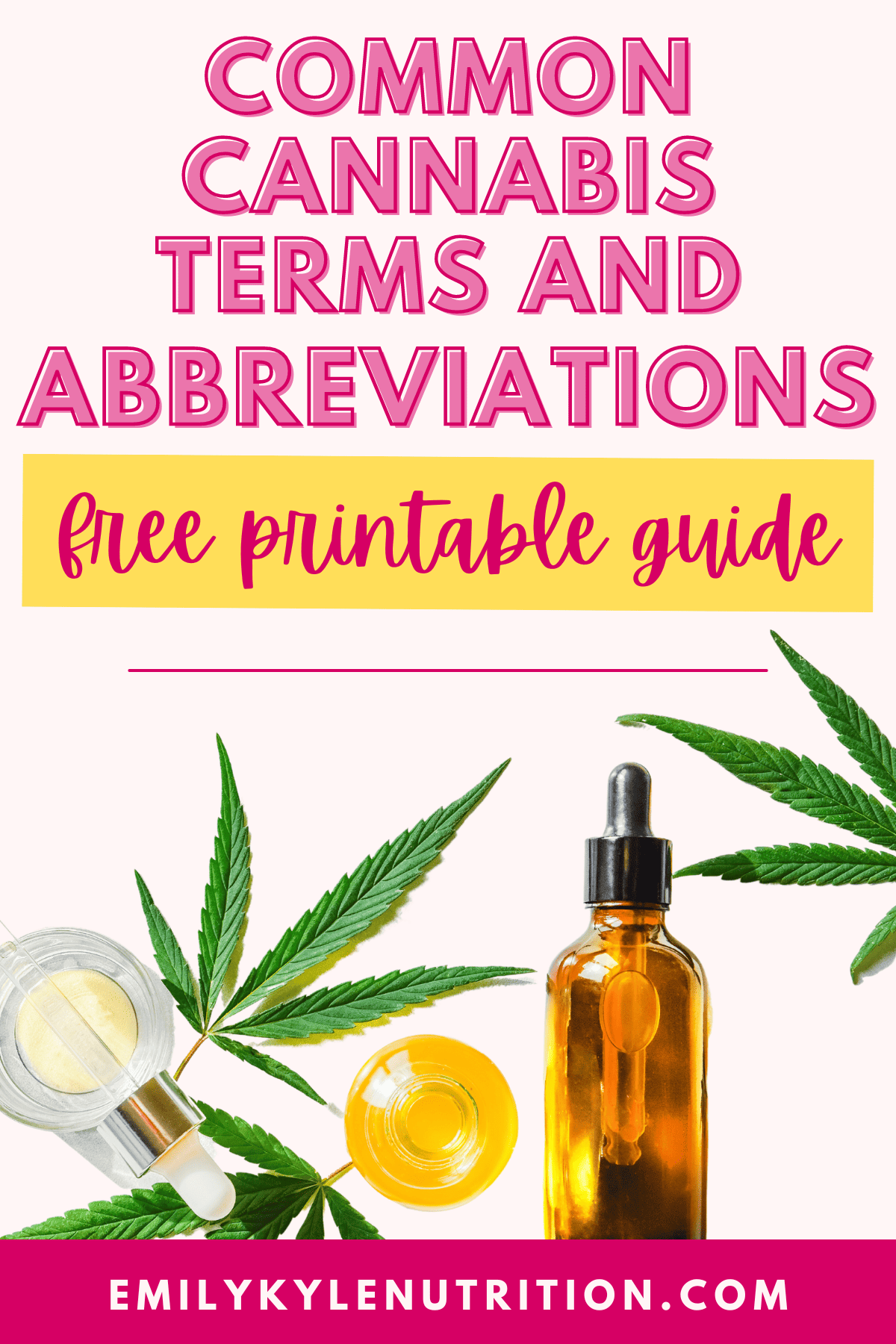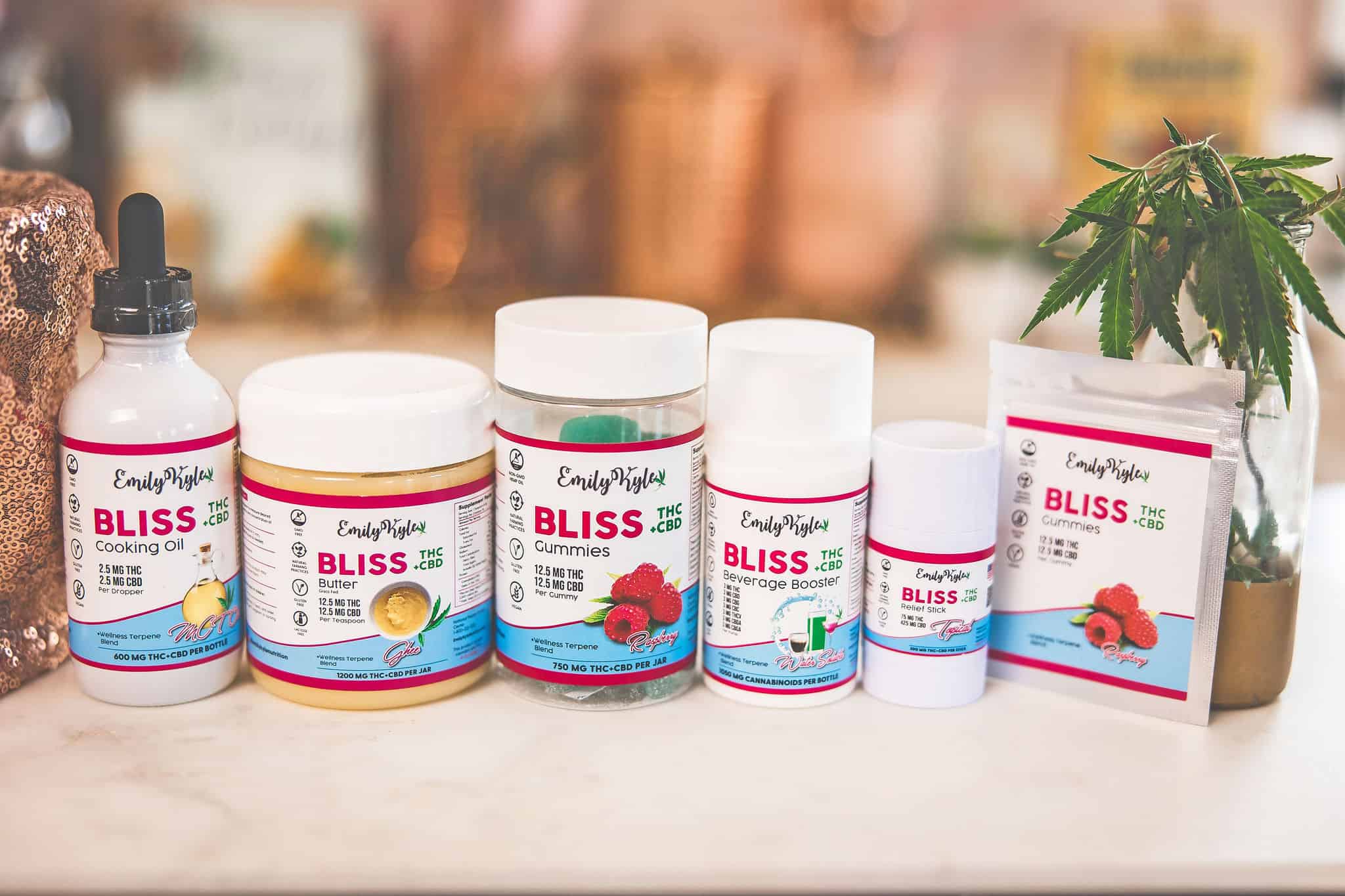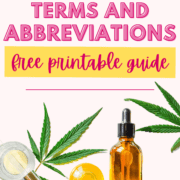Are you feeling overwhelmed by all of the new terms and abbreviations used as you start your cannabis journey? This guide is designed to help cannabis beginners like you make sense of the most commonly used cannabis terms and abbreviations so you can start using cannabis to feel better quickly.

Table of Contents
Article Features
- A beginner-friendly terms and abbreviations guide
- An option to download and print the guide
- Want to make it easy? Shop with me and have high-quality cannabis products delivered directly to your door!

Why You Will Love This Guide
Hello and welcome! If you’re reading this post, I’m guessing you may be new to the world of cannabis.
If so, you’re in the right place, and I’m glad you’re here!
I know that jumping into all things cannabis can feel overwhelming at first.
The acronyms, the names, the long words – it’s a lot.
But it all starts with education, which is where this guide comes in.
My goal is to help you better understand the plant and use it strategically to improve your wellness.
How to Use This Guide
Here I’ve gathered the most common terms, abbreviations, and acronyms in an easy-to-search list so you can quickly find what you’re looking for!
If you want something specific, I recommend using the shortcut “Ctrl + F” on your keyboard to type in the specific term.
Otherwise, please feel free to read through this guide and educate yourself at your own pace.
And if you need more in-depth education, check out my Cannabis Compass Online Course, which will help put all the pieces together at once.
Abbreviations and Acronyms
AVB – already vaped bud. Describing cannabis flower that has undergone dry herb vaporization. Learn more about AVB here.
BHO – butane hash oil, a type of cannabis concentrate that can be made at home.
CBD – cannabidiol, a non-intoxicating cannabinoid. Learn more about CBD here.
CBDA – cannabidiolic acid, a non-intoxicating cannabinoid acid. It is present naturally within the plant. The process of decarboxylation converts CBDA into CBD. Learn more about CBDA here.
CBG – cannabigerol, a non-intoxicating cannabinoid. Oftentimes called the ‘mother cannabinoid’. Learn more about CBG here.
CBGA – cannabigerolic acid, a non-intoxicating cannabinoid acid. It is present naturally within the plant. The process of decarboxylation converts CBGA into CBG.
CBN – cannabinol, a slightly intoxicating cannabinoid acid. Oftentimes called the ‘sleep cannabinoid’ due to its sedative properties. It is not naturally present in the plant and instead comes from the degradation of THC. Learn more about CBN here.
CO – cannabis oil, a general term used to categorize various different types of cannabis oils. Learn more about the different kinds of cannabis oils available here.
ECS – endocannabinoid system, a system present in every human body that interacts with cannabinoids from plants. Learn more about the ECS here.
FECO – full-extract cannabis oil, a powerful cannabis plant extract obtained by evaporating the alcohol from an alcohol-based tincture. This thick oil can be made with different strains to produce different effects, and remains very popular for medical use. Learn more about FECO here.
IP – an Instant Pot, a device that can be used for decarboxylation or infusion, or both. Learn more about using the Instant Pot here.
MBM – a Magic Butter Machine. Learn more about the MBM here.
MCT – medium-chain triglyceride, a type of oil often used in cannabis preparations. Learn more about MCT oil here.
QWET – quick wash extraction technique, a method of making a cannabis tincture. Oftentimes called the ‘Golden Dragon’ or a freezer tincture. Learn more about the QWET method here.
RSO – an acronym for Rick Simpson Oil. Similar to FECO, but prepared with unsafe solvents like isopropyl alcohol and naptha. Learn more about RSO here.
THCA – tetrahydrocannabinolic acid, a non-intoxicating cannabinoid acid. It is present naturally within the plant. The process of decarboxylation converts THCA into THC. Learn more about THCA here.
THC (Δ8) – also called delta-8 tetrahydrocannabinol, is a mostly synthetic derivative of cannabis that provides a less intoxicating experience than delta-9. Learn more about delta-8 THC here.
THC (Δ9) – also called delta-9 tetrahydrocannabinol, the most common cannabinoid found in cannabis. Learn more about delta-9 THC here.
THCV – tetrahydrocannabivarin, a non-intoxicating cannabinoid.
Commonly Used Cannabis Terms
Application method – the way cannabis is used in or outside of the body. Different forms produce different results. Learn more about application methods here.
Ardent – a certain brand of cannabis infusion machines that both decarbs and infuses. Learn more about Ardent products here.
Auto-flowers – a type of cannabis plant that automatically switch from the vegetative growth to the flowering stage with age, regardless of the light cycle.
Broad spectrum – cannabis containing a wide range of cannabinoids, but with the THC removed. Learn more about broad-spectrum products here.
Blunt wraps – a specific type of wrap, typically a tobacco leave from a cigar, that is used to wrap cannabis in to be smoked
Buds – a word used to describe the mature flowers of the marijuana plant. These cannabis flowers contain the most cannabinoids.
Cannabis industry – an umbrella term used to describe any occupation related to cannabis use, whether it be for medicinal purposes or recreational purposes.
Cannabis powder – a term with two different meanings. This can refer to ground, decarbed cannabis that is used in its natural form. This can also refer to cannabis oil powder made with maltodextrin.
Cannabis strain – Each cannabis plant has their own unique characteristics, traits, and chemical compounds. Sativa, Indica, or a mix of both (hybrids) highlight certain features such as size, yield, preferred growth environment, and the kind of therapeutic effect they produce when consumed.
Capsule – a small, empty pill pocket that can be filled with various forms of cannabis. Learn more about cannabis capsules here.
Chlorophyll – a pigment that gives a plant its green hue. It helps a plant make its own food and produce oxygen through photosynthesis. Learn more about chlorophyll here.
Concentrates – cannabis concentrates is a group of several different types of cannabis products that contain cannabinoids in very concentrated forms. Learn more about concentrates here.
Decarboxylation – also called decarb or decarbing, a process required to convert cannabinoid acids to their active cannabinoid form. Learn more about decarboxylation here.
Dosage – how much cannabis, in milligrams, in contained in a serving. This can be determined for edibles using an edibles dosage calculator.
Dry herb vape – an inhalation device that is thought to be safer than smoking. Learn more about dry herb vaporizers here.
Edibles – a range of marijuana-infused products that are meant to be eaten and digested by the body.
Endocannabinoid system – a system present in the human body that helps to maintain homeostasis. Learn more about the endocannabinoid system here.
Endocannabinoid receptors – receptor sites that interact with cannabinoids from cannabis, playing a key role in regulating various physiological processes in the body. These are found throughout the body, from your brain cells to your immune system.
Extraction process – a term used to describe the removal of trichomes from the plant material, commonly done with high-proof alcohol.
Fan leaf – the large, green leaves present on the cannabis plant for the purpose of facilitating photosynthesis. Learn more about fan leaves here.
Female plants – the ones that produce buds, which are the flowering part of the plant and the primary source of cannabinoids. Female plants are ideal for producing the most abundant cannabinoid, THC.
Firecrackers – a simple cannabis recipe that involves sprinkling decarbed flower onto peanut butter on a cracker. Get my firecracker recipe here.
Flower bud – one of the most important parts of the cannabis plant, the flower bud contains the majority of the plant’s trichomes, cannabinoids, and terpenes. Learn more about flower buds here.
Full-spectrum – cannabis contains a wide range of cannabinoids, including THC. Learn more about full-spectrum products here.
Golden dragon – an alcohol-based cannabis preparation also known as a freezer tincture or QWET tincture. This method involves using frozen ingredients and quicker wash times. Learn more about the Golden Dragon tincture here.
Grain alcohol – high-proof alcohol that is ideal for making cannabis tinctures. Learn more about high-proof grain alcohol here.
Green dragon – an alcohol-based cannabis preparation known for its long soak times. Learn more about the Green Dragon tincture here.
Hemp seeds – a nutritious food obtained from the seeds of a cannabis plant. Hemp seeds do not contain any cannabinoids. Learn more about the benefits of hemp seeds here.
Hemp seed oil – a nutritive oil used for cooking. It does not contain cannabinoids and is not the same as CBD oil. Learn more about hemp seed oil here.
Indica – the botanical name Cannabis indica, used to describe the particular species type of plant.
Infusion machine – a small, compact machine that can help infuse your cannabis into butter or oil. There are many different types of these machines. Learn more about infusion machines here.
Kief – the trichome-rich, powdery substance left in the bottom of a cannabis grinder. Sometimes called pollen or dry sift. Learn more about kief here.
Lecithin – is a common ingredient used to make cannabis edibles. It helps bind opposing ingredients together and may help improve bioavailability. Learn more about lecithin here.
LEVO – a certain type of cannabis infusion machine that both decarboxylates and infuses for you. Learn more about LEVO here.
Live resin – a type of cannabis concentrate that’s created using a unique process which involves freezing the cannabis plant immediately after harvest, preserving its original flavor and fragrance
Male plant – are the plant that produce pollen, which is used to fertilize female plants. With a naturally lower THC content, they do not produce the cannabinoid-rich buds and are often removed from cultivation to prevent pollination.
Mary Jane – a slang term used to refer to the cannabis plant.
Medical marijuana – used to describe any type of medical cannabis marijuana use that involves a medical cannabis card and supervision from a healthcare professional.
Munchies – a term used to describe strong food cravings typically associated with post-cannabis consumption. Learn more about the munchies here.
Oil rig – a device used for inhaling different types of cannabis concentrates.
Psychoactive effects – a term used to describe the “high” feeling associated with the consumption of THC, also known as the psychoactive cannabinoid.
Recreational cannabis – used to describe any type of cannabis consumption that does not involve obtaining a medical card. Recreational use may be for relaxation and enjoyment, rather than targeting a specific medical condition.
Root – cannabis roots grow from the stalk of the plant into the ground. They deliver nutrients and water to the plant. They also have their own potential health benefits. Learn more about the roots here.
Ruderalis – the botanical name Cannabis ruderalis, used to describe the particular species type of plant.
Salve – a type of topical preparation often made with cannabis with the purpose of pain relief. Get my cannabis salve recipe here.
Sativa – the botanical name Cannabis sativa, used to describe the particular species of cannabis.
Sublingual – a type of cannabis application method that involves holding the product under the tongue or inside the cheek. Learn more about sublingual absorption here.
Supercritical CO – a safe and efficient method of extracting pure, high-quality essential oils and other substances from plant material by using carbon dioxide in its supercritical state, where it possesses the properties of both a liquid and a gas.
Terpene – volatile organic compounds, essential oils, that give the plant its distinct, unique aroma. Terpenes contain their own unique health benefits. Learn more about terpenes here.
Tincture – a cannabis preparation made using high-proof grain alcohol. There is more than one type of tincture; see Green dragon and Golden dragon. Learn more about the differences here.
Topical – a type of cannabis application method that involves applying cannabis directly onto the skin. Learn more about topicals here.
Trichome – the resinous glands found on the cannabis plant that contain the important cannabinoids and terpenes. Learn more about trichomes here.
Trim – the leaves that are cut off of the plant. These can be fan leaves or sugar leaves. Learn more about trim here.
Vaping – an inhalation method that can involve a vape pen, dry herb vaporizer or a cannabis oil vaporizer. Learn more about vaping cannabis oil here.
Conclusion
As we wrap up, remember that learning new terms and abbreviations is just the beginning of your cannabis journey.
It’s okay if you don’t understand everything right away. After all, every expert was once a beginner too.
This guide is here to support you in navigating through the cannabis world with ease. And remember, if you ever feel overwhelmed, I’m just a click away!
You can always shop with me for high-quality cannabis products delivered right to your door. So, take your time, keep learning, and embrace this exciting journey towards better wellness. You’ve got this!










Hello,
I’ve made this recipe twice and both times the caramel sets but it’s extremely sticky. It sticks to the wax paper (and fingers). Any suggestions to alleviate the stickyness?
Hi Jim. Thanks for trying out the recipe! If your caramel is turning out too sticky, here are a few tips to help with that:
– Cook Longer: Make sure to cook the caramel until it reaches 245°F (118°C) for a firmer consistency. Use a candy thermometer for accuracy.
– Add a Bit of Butter: Incorporating a small amount of unsalted butter into the caramel once it’s cooked can help reduce stickiness.
– Use Parchment Paper: Instead of wax paper, try using parchment paper for cooling and storing your caramel. It’s less likely to stick.
– Cool Completely: Allow the caramel to cool completely at room temperature before cutting or wrapping it.
I hope these tips help! Give them try and let us know!